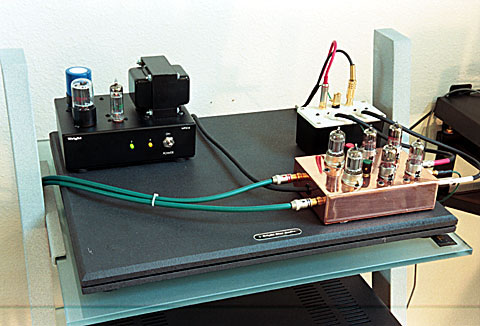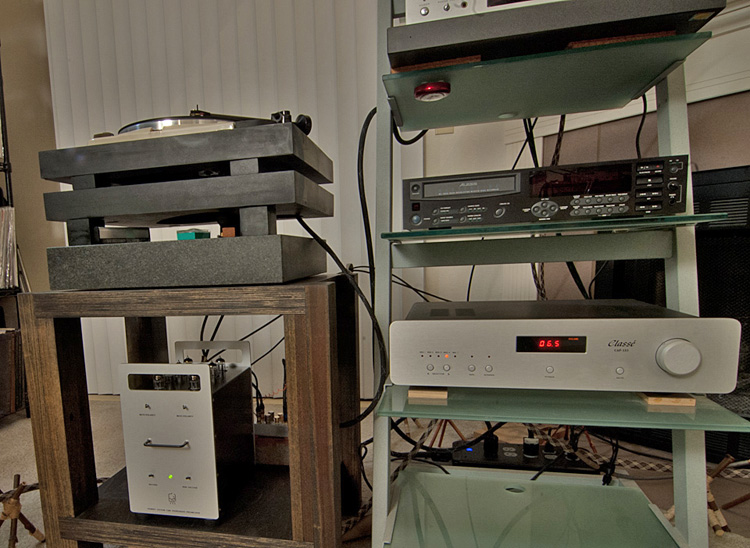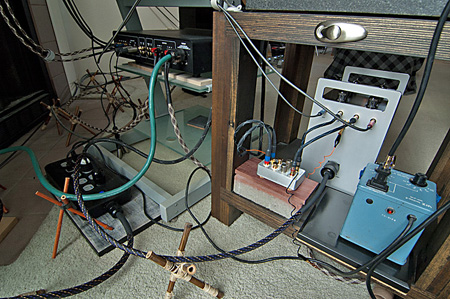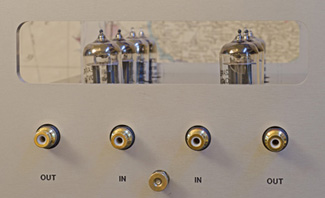-edible zone-
Notes:
02/23/2013
I've been re-thinking my intent to write a review on this piece. If I
write one in the next couple of months I'll miss the opportunity to
describe the phono stage using different associated components later.
Given that, I think I will adjust my intentions a little bit. Rather, I
have used this page to maintain a compendium of my impressions.
Impressions taken over time and as I gathered them. This might be
ultimately more accurate than to write a review two months in, and then
further thoughts one or two years down the road. At least I'll be less
likely to contradict my earlier impressions with later ones....or when I
do it will seem more coherent in the turn of events.
Preface,
system history:
I've been using - for a phono stage - the well
thought of Wright WPP100C. For the past 11 years, that phono stage has
kept me entertained with its very dynamic qualities. My phono cartridge
preference is to use moving coils. The Wright, being a moving magnet
stage provides a 47Kohm resistor at its input and is designed to use
signal voltages on the level of 2mv to 10mv. Therefore it requires a
step-up device in-line on its input side to multiply voltage of the
rather miniscule volts, coming out of your typical low output moving
coil, up to a level it can work with. These voltages tend to be as low
as .2mv to as high as .6mv. I tend to lean toward moving coil step up
transformers for this task. George Wright, maker of the WPP100C, offered
a pair of step up transformers, assembled into a single case, designed
to work with his stage. These would multiply voltage by approximately 10
times. This is what I used during most of those 11 years.... what George
had expertly put together. (another note: the terms "step up
transformer" and "SUT" may be used interchangeably within this article
and refer to the same piece of equipment)
* Wright WPP100C with optional step up.
Wright WPP100C with optional step up.
Lately I have begun using a different pair of step up transformers. (SUT) These are Beyer Dynamic model TR / BV 351 215 006. These offer two different turns ratios of 1:15 and 1: 30 That is; the signal voltage coming out of the MC cartridge gets multiplied by 15 times or by 30 times, depending upon which rca plugs I use on the input side of that little aluminum case. Just below is a photo of the Beyer Dynamic transformer pair as they were used with the Wright phono stage. The copper case with the 6 vacuum tubes up on top is the Wright.
* (click thumbnail to view image full size)
(click thumbnail to view image full size)
I've been pretty happy with the Wright phono stage. It is a very
dynamic sounding unit that gets to the essence of what is exciting about
music. Immediacy. Bass. Extended highs. Articulation of micro and macro
detail. It is a good phono stage. And in consideration of its price at
the time I bought it, a tremendous deal. $875 for the stage with
separate power supply and another $250 for the step up transformer pair.
The Wright does have a few shortcomings. Everything does. The
Wright's major sin, for me, is a tendency to induce some listener
fatigue after a couple hours of steady listening. This may not be
entirely fair for me to say this because I have taken the Wright and put
it into a combination of components, and a room that is likely unique
and slightly different from every other system that a Wright stage might
be used in. In other words, not everyone has the same combination of
amplifier, speakers and room acoustics. And mine is just as unique and
different as is yours.
But you know, there should be no listener
fatigue. That is partly what propelled me to start looking for another
phono stage. The other part was a desire to find a phono stage, that I
could afford, that would allow me to listen/see deeper into the record
groove. A stage that might be able to define and articulate more of what
is there. And so once again I was reading reviews both online and in
magazines about phono stages. There are lots of them out there. Then I
remembered having once met Jim Hagerman, designer and builder of the
Trumpet phono stage. That was at an Audio meet called VSAC that was held
in Washington State back in October, 2003.
At that particular
VSAC, I walked into a room that was demo-ing Jim's Trumpet along with
some other nice gear. I think he was sharing a room with Thom Mackris of
Galibier Turntable fame. At the time I was using a Teres turntable in my
home system and the folks at Teres, also at VSAC, were rather fond of
the Trumpet and using one in their demo room. So I was impressed by that
association, and also by what I heard at VSAC. As I recall I spoke
briefly with Jim and we swapped business cards. The point being that
this Trumpet phono stage is not a new product. It is still in production
and over time has been refined by its maker. It has been reviewed in
Stereophile by Michael Fremer and it has been reviewed around the web in
various audiophile online magazines. Not everyone of these reviews are
dripping over with praise. There is usually a criticism or two regarding
some aspect. Some will object to the unusual dimension of the Trumpet
and state they have no suitable place to put it, because it won't fit
any space they have. Yet, every review I've read did praise the sound
quality coming from this unit.
....moving on to the Hagerman Trumpet MM Phono Stage.......
First part of February. The Trumpet arrived. And I wasted no time,
except to take a couple of photos of it up on the kitchen table. Then I
put the unit into my system -- and to work.
Here's an early
photo:
*
Notice how tall the Hagerman Trumpet is and how conveniently it fits on the bottom shelf of my dedicated turntable stand. Another reason I selected the Trumpet. I had a place to park it
Early listening:
At first I did not listen too closely. At
least I told myself not to. Yet I could not help but notice that the
sounds I was hearing, with the Trumpet in the system, were just as
dynamic as I had known with the Wright, but with more detail. Keep in
mind how when the system reproduces a sound there is a start middle and
trailing end to that sound as it plays through the speakers and out into
the room. At first listen I noticed how the middle part and the trailing
end to cymbal rings seemed to last longer and remain defined as those
notes faded gradually into nothingness. I heard this within the first
hour of use.
I also heard something negative. 60 hz hum. So this,
I figured was a problem to be solved at my end. You can't fairly
evaluate a piece of gear that produces hum. And this was not a very
obvious hum. Barely heard at listening level volumes. And not heard at
all above the music. But, with the stylus out of the groove and the
integrated amp cranked to 3 times normal listening volume there was a
quiet, barely detectable hum. Crank the knob to 5 times normal listening
volume and it was quiet yet very distinct.
I tried different
things. At first I figured some extra grounding straps from the
turntable chassis to the phono stage might help. No success there. Then
I noticed that even without the phono input cables plugged into the
Trumpet, the faint hum was still present and just the same as above.
hmmmm. Or should I say Hummmmmmm. Anyway, I couldn't quite figure it so
I sent an email to Jim. He was gracious and answered my email right
away. And this was on a Sunday afternoon (for me). I was in Seattle. Jim
is in Hawaii. So it must have been late evening there. Anyway I then
sent a photo (the one just below) attached to the next email to show the
setup. Jim's reply suggested that I move that blue tranny that is
standing next to the Trumpet a few inches further away from the Trumpet.
* (click image for a larger one)
(click image for a larger one)
He was right of course. The isolation transformer that I use to
power my Thorens TD124 turntable, and as is shown in the photo above,
was standing right next to the Trumpet. And when I moved that
transformer away, the humming stopped. Whew. It was magnetic induction
happening between the blue tranny and the Trumpet. Problem solved!
Ultimately, I moved the blue tranny a few feet away and onto the lower
shelf of the other rack. And now I notice that residual system noise,
while playing through the Trumpet, is in fact very quiet. More-so than
with the previous Wright phono stage. It is true what other reviewers
say, the Trumpet offers a very quiet background with which to paint its
sonic images.
**About the photo above. Looking at the aluminum
case with the step up transformers, you might notice a black ground wire
coming from the output side of the case. And that this wire is not
making connection to the ground lug on the back of the Trumpet. This is
intentional. It proved to be that the system was quieter to simply clip
the ground wire from the tonearm cables directly to the Trumpet and
leave the ground wire coming from the SUT not connected to anything. In
another group of components this may not be the case. One needs to be
ready for some trial and error on hooking up record players and their
associated downstream components.
I've had the Trumpet in the
system for three weeks now and can offer some observations.
Primarily, I listen to record albums dating back from the early stereo
period ( 1958 and later) and up until CD sales replaced record sales at
record stores. Approximately the middle to late 1980's. The bulk of my
record library is of period records. A small percentage of my library is
of audiophile re-masters on heavy vinyl. I have some of Classic Records
re-masters. Also I have some of the new pressings from Acoustic Sounds
and their Quality Record Pressing operation. I have a few Mobile
Fidelity 1/2 speed masters....and a DCC re-master or two. There is one
Direct-Disk Labs. I have a couple of 45 rpm re-masters from Classic
Records and also Quality Record Pressings. Etc. Etc. With the audiophile
pressings accounted for, the majority of my listening impressions are
from playing old records from the day. And most of these old records are
in remarkably nice condition and sound beautiful. It's why we persist
with this vinyl hobby. The sound of this music is very rewarding.
_______________
3/9/2013
Listening and comparisons
But is it a
winner?....certainly. And definitely it wins over the Wright. In every
way that the Wright is good, the Trumpet is better.
The Wright is
really good at dynamics. But the Trumpet is even more dynamic.
The
Wright is pretty good at delivering fast transients in good definition.
The Trumpet is much better and exhibited this trait to me right away.
The Wright offers very good control over bass and delivers plenty of
it with good definition. But the Trumpet gives even better bass with
greater definition.
etc., etc.
If the Wright lacks some
things, like finesse, micro detail, The Trumpet by comparison shows me
the Wright's shortcoming in those areas.
The Wright always gave
me a case of listener fatigue after a period of time listening. With the
Trumpet I can listen with close focus for hours on end if that is how I
want to spend my days and nights. And with no fatigue.
Enjoyment
levels: Higher than ever. Plus there are no nagging thoughts in the back
of my mind that I might be missing some part of the performance. No
nagging misgivings that I should have spent more for something further
up. No nagging doubts that I paid too much and might just as well stuck
with the Wright.
----------------
3/23/2013
Further listening notes:
For the time being
my reference cartridge is the Shelter 501 type II. I would describe this
particular Shelter as being an overall very good reproducer with a taut
bass at the low end and a fair extension into the high frequency end. It
is fairly quick with transient attack. Enough so to be able to produce
the occasional goose bump or raised hair sensation on the back of the
neck. Not that many cartridges can do this. The Shelter is also famously
noted for reproducing a midrange that possesses some warmth and
intimacy. Acoustic instruments. The human voice. These are reproduced
with considerable texture and detail. Like being up close and personal.
Cellos. Guitars. Wind instruments. You get a really nicely fleshed-out
flavor with these. On percussion instruments you not only get the impact
noises, but a sense of the rushing air being generated within the shell
of the drum.
But what about the Trumpet phono stage? Well,......
any phono stage will be limited by the quality of the signal feeding
into it. Hence the description of the phono cartridge that provides the
source signal. As I see it, the phono stage needs to process the source
signal, feeding into it, in a way that does not degrade, diminish or
alter the character of that source. My listening sessions, so far,
indicate that this Trumpet phono stage is very adept at providing a high
quality output.
I've been listening to a wide variety of musical
genres. From classic rock to jazz to ancient, chamber and romantic
classical. Enjoyment level is higher on these Lps, that I have come to
know, than ever before. More details to come after a longer period.
Associated equipment..........
For the near term I will be
listening to the Trumpet while playing through the thorens TD124 (sn#
2729) that has been restored here, and its resurrection has been
chronicled within the pages of this website. The tonearm is a black Zeta
tonearm equipped with an Incognito silver wired cable set. But the RCA
plugs have been replaced with Eichman Bullet plugs, which I like better
than the standard issue Incognito plugs.....mainly because the Bullets
plug in and pull out a lot smoother than do the Deltron plugs that come
with Incognito harnesses. The phono cartridge is the Shelter 501-II MC
with .4mv output. With this cartridge I use the 1:15 turns ratio inputs
on the BD SUT previously noted. This multiplies voltage to the input
side of the Hagerman up to 6.0mv. That is well within its compatibility
range. The reflected load seen back at the Shelter by this step up
method is 209ohms.
- Speakers: NHT 2.9 4-way towers
- Amp: INtegrated: Classe' CAP 151
- Speaker cables: Canaire 4S11 bi-wired to the NHT speakers
Termination of wire ends is DIY crimp assembled with Silver spades
and covered with Tech-Flex and various pieces of shrink tubing for
appearance and strain relief..

- Interconnects: This varies. There is the custom made Silver wire from the Trumpet to Classe' integrated and assembled by Garth Phillipe of Incognito fame. It is the same wire Garth used to make a phono cable set for my Graham 2.2 tonearm, (to be used on another TT later). Elsewhere I have some Cardas IC wire and plugs diy assembled by yours truly. Etc. And some Canaire microphone cable terminated with AudioQuest RCA plugs. And I have some eichman Bullet RCA plugs here and there...etc. Lots of DIY going on here.
- Power cables: Mostly DIY using Belden bulk cable with termination per the Asylum Power Cable recipe. I have a couple of power cables using DH Labs 12 ga bulk cable with WattGate termination at either end. I did splurge somewhat on the Kimber PK10Gold power cable. This I use between the Classe' integrated and the AC grid at the wall.
- Power Conditionioners: I use a PS Audio Dected power strip for all but one of my system AC hookups. The Dectet operates like a power strip with 10 output plugs but with Surge suppression capability to prevent any possible electrical spikes (from power outages or similar in my neighborhood) This does happen from time to time and so the surge supressor becomes a very good idea for any electrical appliance you can't easily afford to replace. The Dected marketing blurb does profess to offer a modicum of isolation from the other components plugged into it, and also enhanced grounding some basic filtering. I view it as an insurance measure to purchase and use this.







